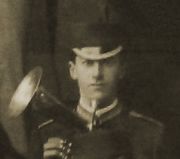Melbourne Tram Museum
- Follow Melbourne Tram Museum on Twitter
- Follow Melbourne Tram Museum on Facebook
- Follow Melbourne Tram Museum on Instagram
- Follow Melbourne Tram Museum on Pinterest
- Follow Melbourne Tram Museum on Tumblr
- Subscribe to Melbourne Tram Museum's RSS feed
- Email Melbourne Tram Museum
Tramway ANZAC: Robert Henry Keir
Distinguished bandsman and tramway career
Over a tramways career spanning more than forty years, Robert (Bob) Henry Keir rose from an ordinary conductor to become the Chief Clerk of the Engineering Department of the Melbourne & Metropolitan Tramways Board (M&MTB). An accomplished musician – one of the first members of the renowned Malvern Tramways Band – Bob was assigned to a military band when he enlisted in the Australian Imperial Force (AIF) in July 1915. He subsequently served with great distinction as a stretcher-bearer in the disastrous Battle of Fromelles.
Early life
Born in South Yarra in December 1889, Bob had grown up in Northern Victoria, one of six children, and attended the Lake Rowan State School. He later lived with his parents in Echuca, and was employed as a grocer. His father, Robert Kirkwood Keir, was a captain on various Murray River steamboats, with a short interlude as the licensee of the Pastoral Hotel in Echuca.
The younger Robert played tenor horn in Echuca’s Federal Band. Established in 1856, the Federal Band is the oldest in Victoria. He had some success as a solo instrumentalist, achieving an Honourable Mention in Ballarat’s 1909 South Street Eisteddfod [1], and winning second prize in the following year, when the Federal Band placed third in the B Grade own content competition.
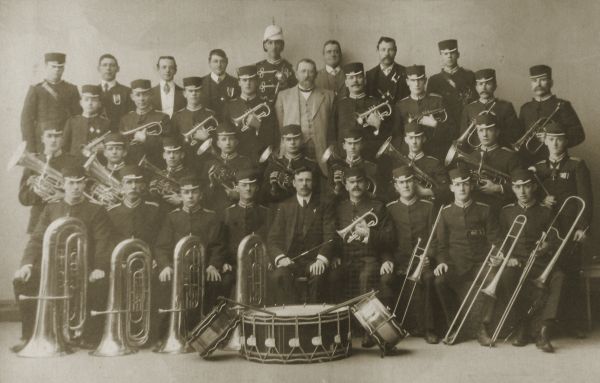
Echuca Federal Band, 1910. Bob Keir is in the second row, fourth from the right.- Photograph courtesy Echuca Federal Band.
In 1911, Bob moved to Melbourne and commenced his tramway career with the Prahran & Malvern Tramways Trust (PMTT). He also continued his musical activities by joining the Malvern Tramways Band. When originally founded in November 1911 the band was known as the Prahran and Malvern Tramway Employees Band, but was renamed shortly after [2]. Bob attended the second meeting of the band, and so would have played in the band’s first performances.
Workplace-oriented recreational and social activities – such as football, cricket, angling and music – were then commonplace amongst large government and industrial organisations. At that time, brass bands were a hugely popular form of entertainment, and companies were keen to provide support in order to enjoy the prestige of their own band.
Once its band was established, the PMTT gave preference to bandsmen when recruiting crews for its trams. Furthermore, any bandsmen missing work to attend rehearsals, concerts or competitions received financial compensation.
Malvern was not Melbourne’s only tramways band – the Melbourne, Brunswick & Coburg Tramways band had its debut a few years later in 1917, and the city’s earliest tramways band, the Melbourne Tramway & Omnibus Company’s Melbourne Tramways Employees Band [3], had been established in 1888.
Bob entered the South Street Eisteddfod again in 1913, achieving another second place for solo tenor horn. That year the band contest was the largest held to date, with 25 bands from all over Victoria, as well as New South Wales, South Australia and Tasmania. The Malvern Tramway Band won second place in B Grade.
War service
With such a strong musical background, it is hardly surprising that Bob was assigned to 29th Battalion’s military band when he enlisted as a private in July 1915. Four months later, Bob embarked for Egypt. Like many newly enlisted soldiers, he married before embarkation. Then after six months in Egypt, he was shipped to France in June 1916.
Military bands were traditionally used for keeping marching columns in step, communication – signalling either within camp or on the field by drum or bugle calls – and to improve morale. By the time of World War I bands had become largely ceremonial, with their prime purpose being largely to boost morale. The Australian military also followed the British tradition of using bandsmen as stretcher-bearers – however after the battle of the Somme in 1916 more stretcher-bearers were needed than were available from the ranks of the bandsmen.
In his role as a stretcher-bearer Bob was required to transport the wounded to safety, typically under appalling and hazardous conditions. Once the wounded were located, stretcher-bearers could take hours transporting them to aid posts, dressing stations or casualty clearing stations. They would often be under fire from the enemy or even friendly fire from their own troops. Casualties amongst stretcher-bearers were high.
It should also be noted that stretcher-bearers were not permitted to carry weapons of any kind.
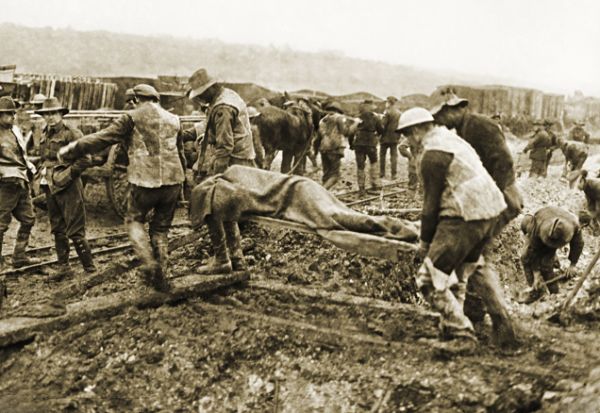
Stretcher bearers transporting wounded of the 4th Australian Division from the front line near Delville Wood, Longueval, France, December 1916. This illustrates some of the conditions that stretcher bearers faced throughout the Battle of the Somme.- Photograph courtesy Australian War Memorial (E00049).
The first major battle for the untried 29th Battalion was at Fromelles on 19 July 1916. The offensive – the first for Australian troops in France – proved to be disastrous. More Australian lives were lost on that one day than on any other in our history.
On 1 July, the British, under the command of General Sir Douglas Haig, had mounted a major offensive in the Somme region, about 100km away. A diversionary attack was planned for the evening of 19 July at Fleurbaix (Fromelles being behind the German lines), with the objective of preventing the Germans from sending reinforcements to their defences in the Somme. A preparatory seven-hour bombardment had little effect on the German defenders, and when the Australian 5th Division and British 61st Division attacked at 6pm they suffered horrendous casualties from machine-gun fire. Some German trenches were captured but were subsequently relinquished due to a lack of flanking support and the fierce counter-attack. At the end of the battle, no ground had been gained.
In that single night, there were 5,533 Australian casualties, including around 2,000 deaths of whom 1,299 were never found [4]. The Germans captured 470 men. The recovery of the wounded continued for another three days.
As a diversionary tactic, Fromelles was an utter failure. The Battle of the Somme, of which Fromelles was just a small part, was to last around five months.
Bob was wounded in that action, but remained on duty. He was mentioned in despatches by General Sir Douglas Haig for his actions at Fromelles, and further distinguished himself on 5 October 1916. He was subsequently awarded the Military Medal on 1 February 1917 and the French Croix de Guerre on 16 February 1917.
His citation for the Croix de Guerre reads:
“This man is a bandsman, also a stretcher bearer. On the night of July 19th/20th 1916 at PETILLON, Pte Keir carried bombs and ammunition to the German trenches, which were being held by our men until the wounded started to come in. He then took up his own work and continued during the whole of the next day, going out into “No Man’s Land” in daylight, securing wounded. While assisting Pte. Hayes, who was mortally wounded, he was also wounded but refused to leave his post; this man showed wonderful endurance. He was always at his post no matter under what conditions. He came under notice again on 5th October 1916 by bringing in two men who had been wounded by snipers, on the tram line leading up to the Subsidiary line, while still under fire.”
Bob was quite slightly built – his attestation form describes him as 5 feet 5¾ inches (167cm) tall, weighing 10 stone (63.5kg) and with an expanded chest measurement of 35½ inches (90cm). Both the physical and mental strain would have been immense.
The 29th Battalion played no major offensive role for the remainder of the year. In early December 1916 the battalion took over the front line from 32nd Battalion, and Bob was wounded for the second time, with his service record noting multiple shrapnel wounds to the thigh and hip.
After being treated for his wounds in France and a short period as an acting corporal on escort duty at the 5th Australian Division Base Depot, Bob rejoined his unit as a private on 30 April 1917. In September he was admitted to hospital with influenza, returning to 29th Battalion on 14 December 1917, being assigned to 8th Brigade Headquarters (BHQ).
In October 1918, 29th Battalion was disbanded, with the men providing reinforcements for other 8th Brigade units. Bob was transferred to 32nd Battalion but remained at 8th BHQ. He was admitted to hospital again with influenza in March 1919 and then transferred to hospital in England. He finally embarked for Melbourne on 3 May, arriving on 21 June, and was discharged from military service on 13 August 1919.
Back to civilian life
When Bob returned to his wife Jane Ann in Melbourne, he had new responsibilities – a daughter born after he embarked for Europe. A second daughter followed in 1920. The family lived at 3 Edith Street, Caulfield, but by 1921 had moved to 24 Euston Street Malvern (now demolished). They later moved next door to 22 Euston Street.
He also resumed employment with the tramways. In February 1920 the various municipal tramway trusts – including the PMTT – were merged into a single entity, the Melbourne & Metropolitan Tramways Board (M&MTB). In this new organisation Bob held the position of Time Clerk within M&MTB’s Eastern System, which consisted of the PMTT and Hawthorn Tramway Trust (HTT) systems.
The Time Clerk’s duties were to reconcile the times worked by the drivers and conductors against the rosters. Shift management was a complex task – there could be several hundred men based at a depot, permanent and casual staff, across morning, evening and split shifts.
Bob continued his musical activities, rejoining the Malvern Tramways Band, but now he was playing the B♭ cornet. His younger brother Fred had also joined the band, playing the same instrument. Bob competed as a solo instrumentalist at the South Street Eisteddfod, with some success in the solo cornet contests over the period 1921 to 1935:
- 1921 – Amateur B♭ Cornet Solo “Rocked in the Cradle” (L.P. Laurendean), second; Champion B♭ Cornet Solo “Neath Austral Skies” Honourable Mention
- 1923 – Champion Cornet solo, equal third
- 1933 – B♭ Cornet Solo – “Valse Caprice” (P Code), Honourable Mention
- 1935 – B♭ Cornet Solo – “Allergo Symphonique”, Honourable Mention
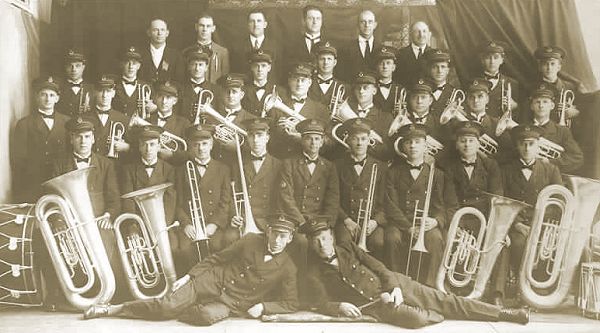
Malvern Tramways Band, A Grade Champions 1926. We believe Bob Keir is in the second row, second from the left.- Photograph courtesy Stonnington History Centre.
There were no brass events at South Street from 1925 to 1931 due to a conflict with the Victorian Band Association. He did compete in other solo cornet contests, achieving third place in the champion cornet solo at the 1925 Brunswick Carnival. Unfortunately at the solo cornet contest in the 1926 Toowoomba Band Carnival, he had to retire due to instrument trouble.
Malvern Tramway Band’s 1930 list of bandsmen notes that Bob was “a great executant” – in other words, he was an excellent musician. As a valued member of the Malvern Tramways Band, Bob would have been a key part of the band’s competition successes over its first 20 years. As well as competitions, the band also performed at municipal, charity and fund-raising events, recitals at Wattle Park, and was even broadcast on ABC radio – where on two occasions in 1931 Bob was listed as a soloist. However Bob did not participate in the band’s renowned 1925 tour of New Zealand, where it won many prizes, including the New Zealand Championship Shield.
During this period, Bob’s tramway career had also progressed. By the early 1930s, Bob was based at the M&MTB’s head office, where he was Senior Permanent Way Clerk. The permanent way engineers were responsible for the design, construction and maintenance of all the M&MTB’s tramway track. The conversion from cable to electric tramways had commenced in 1925 and would continue through to 1956. Over this period over 76 miles (122 kilometres) of cable tramway track were replaced – an enormous undertaking – as well as a number of new electric tramlines constructed. Bob’s role as Senior Permanent Way Clerk was that of an office manager. He would have ensured that the paperwork of the technical staff was in order, correspondence was appropriately handled and administrative tasks performed, as well as overseeing the other clerks in the office. In the days before computers, when everything was manually recorded, a good Senior Clerk was essential to keep the office running smoothly – it was a highly regarded position within the M&MTB.
Bandmaster in the Militia
After the heavy expenditure during World War I the Federal Government had slashed its defence budget. In 1922 large numbers of permanent military personnel were retrenched. Training quotas for the compulsory military service scheme (“Universal Training”) – introduced in 1911 – were reduced, being conducted only in major urban areas. Then in 1929 the Government abolished compulsory military service. The stated aim was to maintain a volunteer force based on the part-time Citizen Military Forces (also known as the Militia).
Although the intention was that the Militia would be provided with new equipment, this never eventuated. Materiel was surplus from the war, much being obsolete or in poor condition. Attracting volunteers was difficult and the Defence forces were grossly below strength. With the economic depression of the 1930s, it could be problematic for those in paid employment to take leave for training activities.
In July 1933 Bob enlisted in the Militia. He was initially assigned as Bandmaster (Sergeant) with the 59th Battalion, however two years later he was transferred to the 14th Battalion (Prahran Regiment, also known as Jacka’s mob after Albert Jacka, recipient of Australia’s first Victoria Cross in World War I). Bob signed up for a second three-year period, and in October 1937 was promoted to Warrant Officer II.
Militia bands participated in various ceremonial events, such as ANZAC Day, and Trooping the Colour. Bob also performed as a bugler, on one occasion playing the Last Post at the unveiling of the Oakleigh war memorial [5] in 1933.
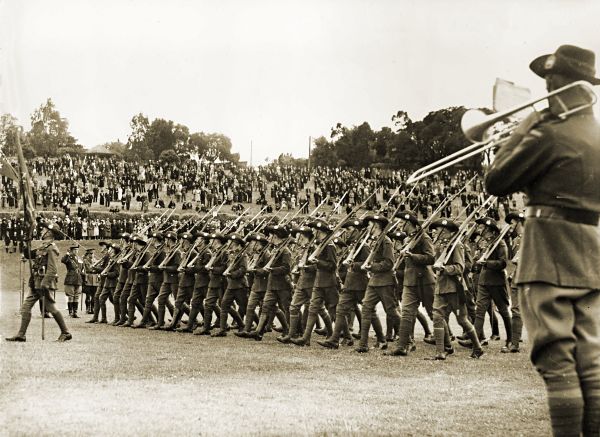
Trooping the Colour, 14th Battalion, Como Park, South Yarra, c1936-1938.- Photograph courtesy Argus Newspaper Collection of Photographs, State Library of Victoria.
In the mid-1930s the Keir family moved from their Euston Street home to 1522 Malvern Road, Gardiner (now demolished). Bob did not enlist in World War II – in 1939 he turned 50 and thus was too old to serve. The age limits for recruits in 1939 were 20 to 35 years, and under exceptional circumstances up to 40 years for officers and some non-commissioned officers.
Post military life
During the 1940s Bob was the Secretary of the Glen Iris branch of the Returned Sailors’ Soldiers’ and Airmen’s Imperial League of Australia (now known as the Returned & Service League, or RSL).
His tramway career continued to progress – Bob was promoted to Chief Clerk of the Engineering Department of the M&MTB. The Chief Clerk was responsible for all the clerical staff and administration of the various branches of the Engineering Department, including Permanent Way, Rolling Stock, Distribution, Building, Testing and Bus Branches. It was one of the most senior roles within the M&MTB.
Bob was also active in the Municipal Officers’ Association [6] – the union covering clerical staff in local and State government utilities – as a member of the M&MTB Sub-Branch and State Committees of the union.
Bob continued working at the M&MTB, until he reached retirement age in December 1954. The M&MTB paid its employees retirement gratuities based on length of service, the reason for retirement and the age of the employee; at that time the maximum retirement gratuity was 104 weeks’ salary. At 65 years of age with 43 years in the tramways – the M&MTB counted time served in the military towards service – Bob would have received a retirement gratuity equivalent to 101 weeks’ salary.
In 1961, the Malvern Municipal Band – formerly the Malvern Tramways Band – celebrated its 50-year jubilee. Past and present band members attended the celebration, including Bob and his brother Fred, although by this time neither of them were playing with the band.
Bob died in December 1971, aged 82, survived by Jane Ann, his wife of 56 years, his two daughters and their families.
Acknowledgements
Many thanks to everyone who provided advice and assistance, with special thanks to Simone Sharp of Stonnington History Centre, Doug Morison of Echuca Federal Band, Jane Nigro of Malvern Historical Society, Fred Pratt of the RSL, Elaine Hillier of Stonnington City Brass, and from the Melbourne Tram Museum, Warren Doubleday, Russell Jones and Mike Ryan.
Bibliography
The Argus (1913), Champion Band Contest Ballarat Results, 27 October 1913, page 5
The Argus (1933), Soldiers Memorial Unveiled at Oakleigh, 13 November 1933, page 9
Australian Army (2016), Fromelles
Australian Imperial Force unit war diaries, 29th Battalion, July 1916
Australian Imperial Force unit war diaries, 29th Battalion, December 1916
Australian War Memorial, 29th Australian Infantry Battalion
The Brisbane Courier (1926), Band carnival, 1 April 1926, page 9
Peter Burness (2008), The worst night in Australian military history: Fromelles, AWM blog, 18 July 2008
Chronicle (1931), Radio Broadcasting, 8 October 1931, page 48
Geelong Advertiser (1913), South-St Band Contests, 23 October 1913, page 4
Graeme Hosken and Tom Joy (2011), Bandsmen and stretcher-bearers: why were bandsmen also stretcher-bearers?, Military History and Heritage Victoria
J. Grey (2008), A Military History of Australia, third edition, Cambridge University Press
Lt Gen Sir Carl Jess (1945), Report on the activities of the Australian military forces 1929 – 1939
M. Johnston (1996), “The civilians who joined up, 1939-45”, Journal of the Australian War Memorial, issue 29, November 1996
Malvern Tramways Band, papers held at Stonnington History Centre
Melbourne & Metropolitan Tramways Board (1920), Statement of Salaries and Wages paid and Allowances to Employees for year ended 30/6/20
Melbourne & Metropolitan Tramways Board (1955), Retiring and Death Gratuities, notice to employees, 31 March 1955
Melbourne & Metropolitan Tramways Board (1956), Annual Report 1956
C.C. Mullen (1965), “Brass Bands have played a Prominent Part in the History of Victoria”, Victorian Historical Magazine 139:36, pp30-47
National Archives of Australia (1914-1918), Robert Henry Keir – Service Record
National Archives of Australia (1933-1946), Robert Henry Keir – Attestation Form
The Prahran Telegraph (1925), Malvern Tramways Band Recent New Zealand Tour, 22 May 1925, page 6
Public Record Office Victoria (1931-1970), List of Employees, Tramways, Bus and Railways, VPRS 13706 P0005
The Queenslander (1931), Radio Broadcasts, 11 June 1931, page 46
Riverine Herald (1913), Echuca Successes, 21 October 1913, page 2
Riverine Herald (1920), Cornetist’s Success, 21 October 1920, page 2
Royal South Street, Results
C.R. Snelling, History of the Malvern Municipal and Prahran Tramways Band by one of its pioneers, undated manuscript held by Stonnington History Centre
The Sun (1971), Deaths, 31 December 1971
Tramway Circuit (1954), Personal Pars, December 1954, page 13
Footnotes
[1] Founded in 1891, South Street (known as Royal South Street from 1962) is Australia’s oldest eisteddfod and is now Australia’s largest performing arts competition. The annual events run from July to October and encompass a number of disciplines, including music, dance, drama, recitation and calisthenics. Brass band and brass solo contests were first held in 1900.
[2] The Malvern Tramways Band underwent further changes to its name: in 1946 the band became the Malvern Municipal Band, as most of its tramway members had moved on, and then in 2000 it was renamed Stonnington City Brass, the name by which it is known today.
[3] Other tramway bands included the Northcote Tramway Band, founded in 1895, and the Brunswick Tramways Jazz Band (1922-25). The band now known as the Melbourne Tramways Band was formed in the late 1930s, and has been playing regularly at Wattle Park since the 1940s.
[4] In a joint project by the Australian Army and the UK Department of Defence, a mass grave was discovered in 2008, containing the remains of 250 Australian and British troops buried by the Germans after the Battle of Fromelles. As at May 2016, 130 of the 211 Australians had been identified.
[5] The Oakleigh war memorial was originally erected on the corner of Dandenong and Warrigal Roads. It was moved to Warrawee Park, Oakleigh in 1965.
[6] A series of amalgamations in the early 1990s resulted in the Municipal Officers’ Association eventually being absorbed within the Australian Services Union.
